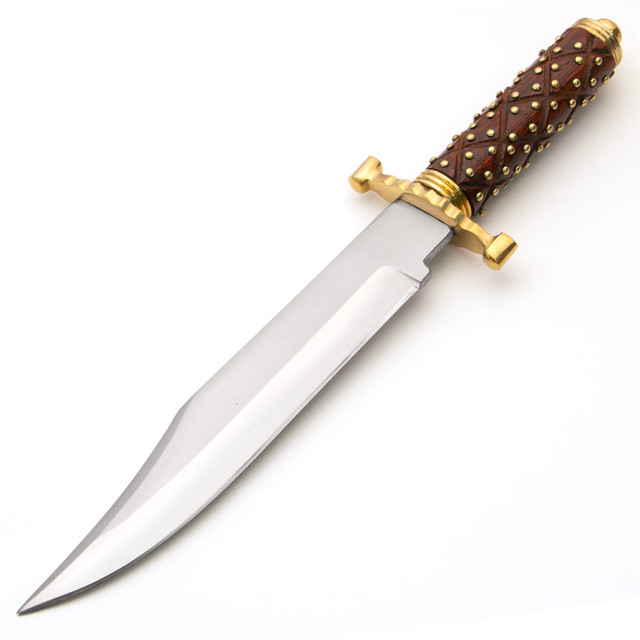The Bowie Knife: Anatomy, Origins, and Utility
19th Feb 2024
The Bowie knife, a quintessential symbol of American craftsmanship and ingenuity, has captured the imaginations of enthusiasts and collectors alike. In this exploration, we delve into the various facets of the Bowie knife, from its anatomy and historical origins to its practical utility and enduring legacy.
Parts of a Bowie Knife
Before we unravel the intrigue surrounding the Bowie knife, let's dissect its anatomy. A typical Bowie knife comprises several essential components:
- Blade: The blade of a Bowie knife is characterized by its distinctive shape, featuring a clip point or a spear point for precision cutting and piercing.
- Guard: Positioned between the blade and the handle, the guard serves to protect the user's hand and enhance grip stability during use.
- Handle: Often crafted from materials such as wood, bone, or synthetic composites, the handle provides comfort and control, enabling precise handling of the knife.
- Pommel: Situated at the base of the handle, the pommel serves both functional and aesthetic purposes, balancing the knife's weight and adding visual appeal to its design.
What Does a Bowie Knife Look Like?
The iconic Bowie knife is instantly recognizable by its distinct features. Characterized by a robust blade with a clipped or spear point, a sturdy guard, and a handle designed for ergonomic grip, the Bowie knife exudes both functionality and elegance. Its design reflects a blend of practicality and aesthetics, making it a timeless masterpiece cherished by collectors and outdoor enthusiasts alike.
Who Invented the Bowie Knife?
The origins of the Bowie knife trace back to the early 19th century, shrouded in the legend of American folk hero Jim Bowie. While the exact inventor remains a subject of debate, Jim Bowie's association with the knife during the Sandbar Fight of 1827 solidified its place in history. Whether crafted by blacksmith James Black or improvised by Jim Bowie himself, the Bowie knife's legacy endures as a testament to innovation and resourcefulness.
What are Bowie Knives For?
The versatility of the Bowie knife extends far beyond its origins as a tool for self-defense. Renowned for its rugged durability and precision craftsmanship, the Bowie knife finds application in various scenarios, including:
- Survival and outdoor activities
- Hunting and field dressing game
- Bushcraft and wilderness exploration
- Collecting and historical appreciation
Who Made the Bowie Knife?
While the exact individual responsible for inventing the Bowie knife remains a subject of historical conjecture, blacksmith James Black is often credited with crafting the original blade. However, the knife's widespread popularity and evolution owe much to the ingenuity and craftsmanship of countless artisans and manufacturers over the years.
What Makes a Knife a Bowie?
A Bowie knife is distinguished by its characteristic features, including a large, fixed blade with a clip or spear point, a guard for hand protection, and a robust construction suitable for various tasks. Its design emphasizes versatility, durability, and balance, making it an indispensable tool in diverse environments.
What Are the Advantages of a Bowie Knife?
The Bowie knife offers several advantages over conventional knives, including:
- Superior cutting and piercing capabilities
- Enhanced durability and strength
- Versatility for a wide range of tasks
- Aesthetic appeal and historical significance
Can a Bowie Knife Stab?
While primarily designed for cutting and piercing, the Bowie knife's sturdy construction and sharp point make it capable of stabbing when necessary. However, its utility extends beyond combat to include everyday tasks such as food preparation and utility work.
Do Soldiers Use Bowie Knives?
While soldiers historically carried Bowie knives for personal defense and utility purposes, modern military equipment typically includes specialized combat knives designed for specific tactical roles. However, Bowie knives remain popular among outdoor enthusiasts and collectors for their craftsmanship and historical significance.
Did Rambo Use a Bowie Knife?
The character of Rambo, portrayed by Sylvester Stallone in the iconic film series, is often depicted wielding a survival knife with similarities to a Bowie knife. While the knife used in the films may resemble a Bowie knife, it is not explicitly identified as such.
Is a Bowie Knife the Best Fighting Knife?
The effectiveness of a knife in combat depends on various factors, including its design, blade geometry, and the skill of the wielder. While the Bowie knife's reputation for ruggedness and versatility makes it a formidable tool in close-quarters combat, preferences and tactical considerations may vary among users.
In conclusion, the Bowie knife stands as a testament to American craftsmanship and ingenuity, embodying a legacy of resilience and adaptability. Whether wielded for practical utility or admired for its historical significance, the Bowie knife continues to captivate enthusiasts worldwide, its enduring allure undiminished by the passage of time.


 Gift Cards
Gift Cards
